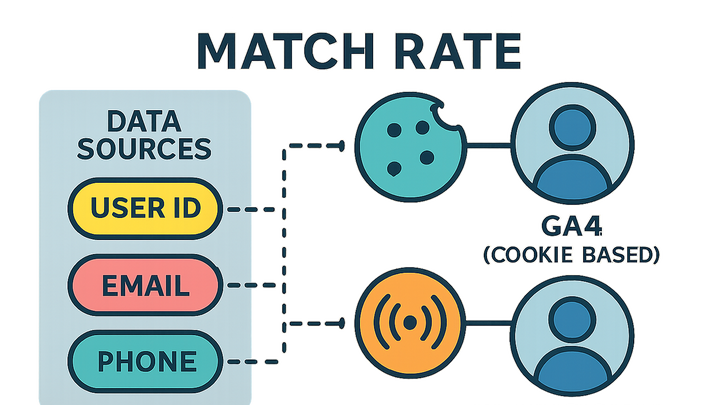Published on 2025-06-22T08:19:15Z
What is Match Rate? Examples of Match Rate
The Match Rate in web analytics measures the percentage of collected user identifiers that can be successfully matched to known user profiles or sessions. It is a key indicator of data completeness and accuracy in tracking systems. A high match rate ensures reliable attribution, robust user journey analysis, and effective personalization strategies. In cookie-free analytics (e.g., PlainSignal), match rate relies on server-side fingerprinting and deterministic identifiers. In cookie-based platforms (e.g., Google Analytics 4), it depends on first-party cookies and unique user IDs. Monitoring match rate helps you identify tracking gaps, optimize implementations, and improve overall data quality.
Match rate
Percentage of collected user identifiers successfully matched to analytics platform profiles.
Definition and Context
Match Rate represents the ratio of matched identifiers to the total identifiers collected. It provides insight into how well your analytics system can link data points to real user sessions or profiles.
Why Match Rate Matters
A strong match rate ensures accurate attribution, reliable user journey mapping, and confident decision-making. Low match rates can indicate tracking gaps, privacy constraints, or implementation issues.
How Match Rate is Calculated
Match Rate is generally calculated using a simple formula and varies slightly between cookie-based and cookie-free systems.
-
General formula
Match Rate = (Matched Identifiers / Total Identifiers Collected) × 100
-
Cookie-based tracking (GA4)
In Google Analytics 4, match rate depends on first-party cookies and the
user_pseudo_id. When cookies expire or are blocked, match rate decreases. -
Cookie-free tracking (PlainSignal)
PlainSignal uses server-side fingerprinting (IP, user agent, timestamps) and deterministic identifiers to match sessions without relying on cookies. Match rate varies by fingerprint uniqueness.
Improving Your Match Rate
Optimizing match rate involves ensuring consistent identifier capture and robust tracking setups.
-
Use a unified user id
Implement a persistent user ID (e.g., hashed email) across platforms to improve deterministic matching.
-
Optimize tracking scripts
Ensure tracking snippets load on all pages and correct errors in custom setups to maximize identifier collection.
Examples: PlainSignal and GA4
Practical implementation snippets and match rate analysis in both cookie-free and cookie-based analytics tools.
-
PlainSignal (cookie-free analytics)
Install PlainSignal with the following snippet, then review the match rate in its dashboard:
<link rel="preconnect" href="//eu.plainsignal.com/" crossorigin /> <script defer data-do="yourwebsitedomain.com" data-id="0GQV1xmtzQQ" data-api="//eu.plainsignal.com" src="//cdn.plainsignal.com/plainsignal-min.js"></script> -
Google analytics 4
Add the GA4 tag to your site and monitor match rate via the
user_pseudo_idcoverage report:<!-- GA4 Tracking Snippet --> <script async src="https://www.googletagmanager.com/gtag/js?id=G-XXXXXXXXXX"></script> <script> window.dataLayer = window.dataLayer || []; function gtag(){dataLayer.push(arguments);} gtag('js', new Date()); gtag('config', 'G-XXXXXXXXXX'); </script>
